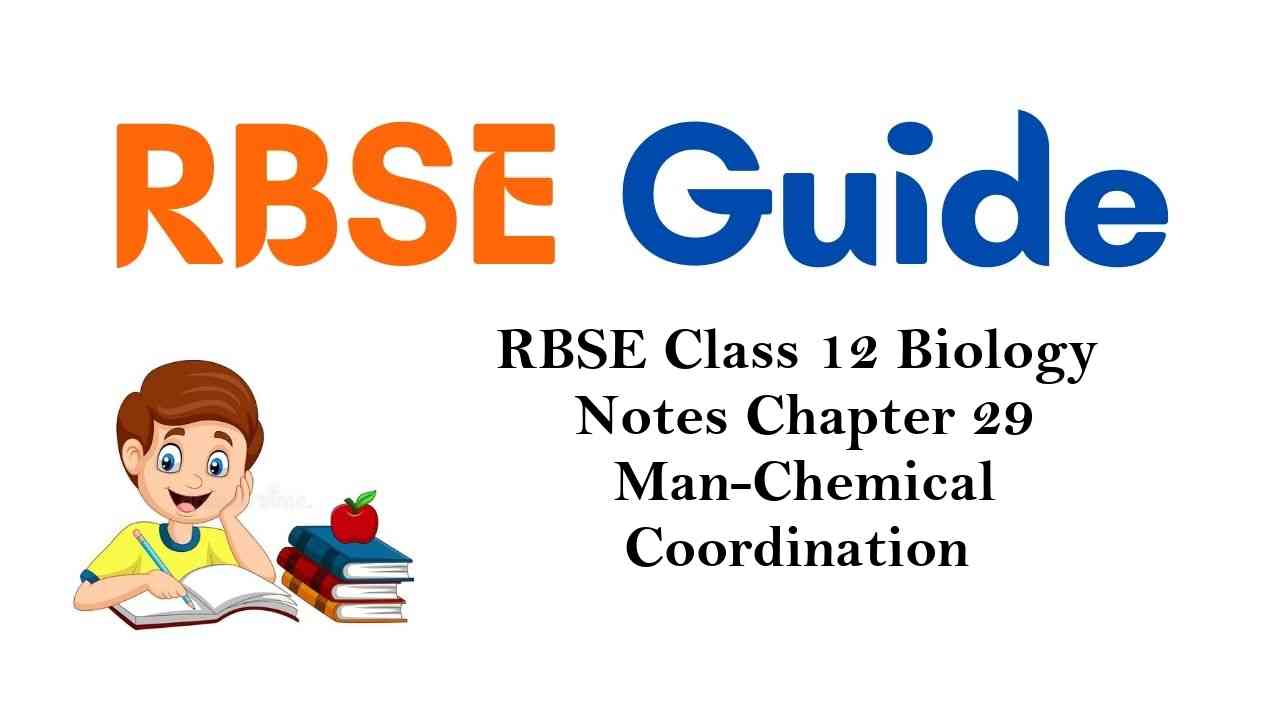Rajasthan Board RBSE Class 12 Biology Notes Chapter 29 Man-Chemical Coordination
General
- The endocrine system includes endocrine glands &. hormones. The study of endocrine system & associated diseases is called as endocrinology.
- The endocrine system is under the control of brain. The study of control of endocrine system by brain is called as neuroendocrinology.
- The endocrine glands are ductless glands which pour their secretions into the blood for transportation.
- Their secretions are called as hormones.
Human body consists of three types of glands :
(i) Exocrine glands : These glands discharge their secretions into the ducts and called Ducted Glands. Glands are present near the site of their action and pour their secretions into the ducts.
(ii) Endocrine glands : These glands are ductless and discharge their secretions into the blood. These glands may be present far away from the site of their action. Chemical substances secreted by these glands are called hormones. Examples: Pituitary gland, thyroid gland & parathyroid gland etc.
(iii) Mixed glands : Some glands which function like exocrine and endocrine both are termed as mixed glands.
Example – Pancreas
- Claude Bernard (1855) used first time the word internal secretion.
- Bayliss and Starling (1903) first time obtained hormone from secretory – cell of mucous membrane of duodenum and named it Secretin.
- Term hormone was coined by Starling (1905).
- Thomas Adison is known as Father of Endocrinology.
![]()
Hormones
Term ‘Hormone’ was first used by Starling.
Hormone is a messenger which is secreted by a part & released directly into the blood for body circulation.
The effect of hormone is long and gradual.
Hormones normally control following processes
- Reproductive processes
- Metabolism & Homeostasis
- Maturation, growth & regeneration
- Adaptation to external factors
Hormones are not associated with any group of chemical compound. Some hormones are steroids eg androgen, estrogen, adrenocorticosteroids etc;, some are proteins eg. insulin, glucagon, partathormone, oxytocin, vasopressin etc. and some hormones are neither proteins nor steroids eg. Adrenalin, nor-adrenalin.
Their molecular weight is less & they can easily pass through the cells.
They are soluble in water & easily diffusable in the tissues.
They do not exhibit cummulative effect. They are destroyed/excreted after the work is completed. They are secreted constantly.
Hormones are organic catalysts. They may act as co – enzyme.
They are required & secreted in small quantity because they are highly active substance.
Their deficiency/excess is harmful and causes hormonal diseases.
Most of the hormones do not enter into the target cell accept the steroid hormones & the thyroxine.
The hormones circulate in the whole body but every hormone has a definite site of action which is called as target organ. The target cell itself has the chemical arrangement to receive the hormone from the blood. Mostly, the protein hormones bind to the special receptors found on the plasmalemma.
As a result, the adenyl cyclase enzyme activates & convert ATP into cyclic AMP. This cAMP migrate to the nucleus & affect the cellular metabolism. Hence, hormone acts as first messenger and CAMP as second messenger.
Most of the hormones exhibit feed back mechanism. Thus, the hormone controls the functioning of the target cell in one way & on the other way the target cell controls the rate of secretion of the hormone.

Endocrine Glands in Man
In human beings & other mammals,”following endocrine glands are found:
(A) Endocrine glands:
- Pituitary glands
- Pineal body
- Thyroid
- Parathyroid
- Thymus
- Adrenal gland
(B) Mixed glands:
- Pancrease
(C) Other organs:
- Kidneys
- Testes
- Ovaries
- Placenta
- Gastro-intestinal mucosa
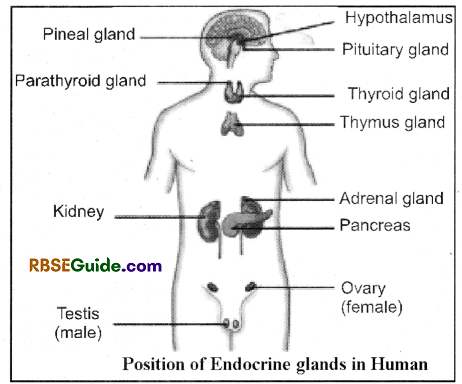
![]()
Hypothalamus
General
Hypothalamus is a part of fore brain and forms the floor of cavity of diencephalon, diocoel or third ventricle. Hypothalamus contains many area of grey matter, which are called as hypothalamic nuclei. These synthesize specific releasing & inhibiting factors, which stimulate secretions of various hormones from the anterior pituitary.
Pitiuitary gland is attached with hypothalamus by a stalkcalled infundibulum just below the hypothalamus.
Two types of hormones releasing hormones and inhibiting hormones are synthesized by hypothalamus. These control production and secretions of pituitary hormones and hence hypothalamus is considered as supreme commander of endocrine regulation or Master of the master gland.
RF & IF (Hormones) secreted by Hypothalamus
Hypothalamus secrete approximately ten types of neurohormones, which control secretions of pituitary gland.
Out of them 7 are releasing factors ( RF) and 3 are Inhibiting Factors) (IF).
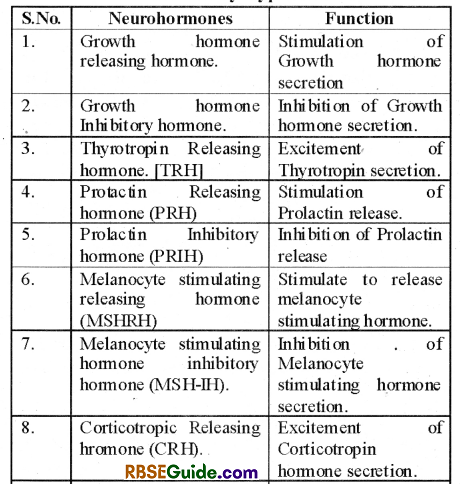

Pituitary Gland
General
It is a pea-shaped gland which remains attached to the hypothalamus with the help of an infundibulum. It remains situated in a shallow depression called sella tursica found in sphenoid bone.
It’s measurements in man are 10 mm x 6 mm x 13mm. It’s weight in man is 550 mg & in woman is 650 mg. This gland is also called as hypophysis cerebri or hypophyseal gland.
Earlier, it was called as master gland. Now, it becomes clear that the pituitary is controlled by the hypothalamus. Hence, it is also called as hypothalamo – hypophvseal gland.
It controls most of the endocrine glands. Hence, it is also called as leader of endocrine orchestra.
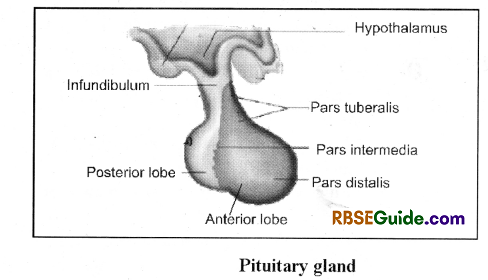
Structure of Pituitary :
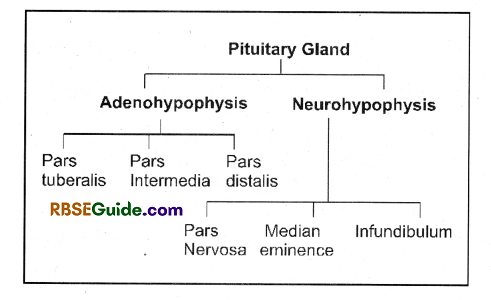
Pituitary gland is composed of two lobules.
Adenohypophysis or Anterior lobe
- It is derived from outgrowth of embryonic pharyngeal ectoderm as buccal diverticulum. It is 75% part of
- pituitary gland. It is made up of glandular epithelial cells. It has three parts:
- Pars tuberalis : It is a collar like structure around stalk. It is not clear in human and its role is 29.5.2 Structure of Pituitary obscure.
- Pars intermedia : It is located between both lobules of pituitary gland. One hormone is secreted by this part.
- Pars distalis : It is the largest part of adenohypophysis. It secrete six hormones.
Neurohypophysis or Posterior lobe
It is one-fourth part of pituitary gland and derived from infundibulum of hypothalamus. It is posterior part of pituitary gland. It has three parts
- Pars nervosa : It is situated at the corner of stalk and a swollen part of the gland. It stores the hormones secreted by the hypothalamus.
- Pars Eminence : At the base of hypothalamus.
- Infundibulum : It is stalk and swollen part of hypothalamus.
Hormones of Pituitary Gland
Hormones of Adenohypophysis
This part secretes seven main hormones which are controlled by the controlling factors secreted by the hypothalamus. These factors are transported to the adeno-hypophysis through the hypothalamo- hypophyseal portal system.
These hormones are as follows-
1. Growth hormone (GH) or Somatotraphic hormone (STH):
- It is a simple protein secreted by anterior pituitary.
- It controls body growth and the skeletal growth.
- It stimulates synthesis of milk in the mammary glands of woman.
- It prevents tissue damage & stimulates cell division.
- GH-RF stimulates it’s secretion
![]()
Diseases
(a) Deficiency of GH in children causes Dw arfism which is also called as Nanism & Ateleosis. The dw arfs working in the circus are also called as midgets. Their height is less than 4 feet.
(b) Excess of GH in children results gigantism. The body length is more than 7 feet.
(c) Deficiency of GH in adults causes Sinimond’s disease. Appearance of ageing symptoms during youth such as wrinkling of skin, greying of hair etc.
(d) Excess of GH in adults causes acromegaly. It is characterized by Kyphosis & thickning of joints & jaw bones.
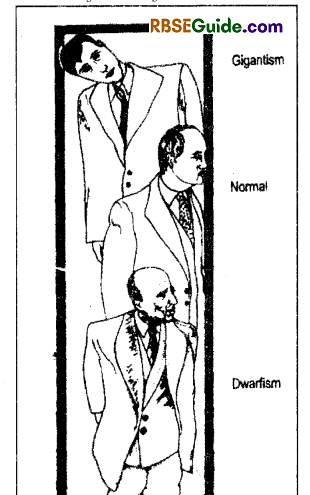
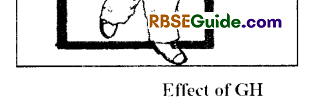
2. Adrenocorticotrophic hormone (ACTH):
- It is a simple protein which is secreted by the anterior pituitary.
- It controls adrenal cortex.
- It is under the control of ACTH – RF.
3. Thyroid stimulating hormone (TSH):
- It is a simple protein which is secreted by
- the anterior pituitary.
- It controls thyroid gland.
- It is under the control of TSH – RF.
4. Follicle stimulating hormone (FSH):
- It is also called as gametokinetic factor.
- It is a glycoprotein which is secreted by the anterior pituitary.
- It is under the control of FSH-RF.
- It controls spermatogenesis in male.
- In female, it controls oogenesis & secretion of estrogen.
5. Luteinizing hormone (LH) or Interstitial cell stimulating hormone:
- It is a glycoprotein which is secreted by the anterior pituitary.
- It is secreted under the control of LH-RF.
- In male, it controls secretion of androgen hormone from the interstitial or Leyding cells.
- In female, it controls secretion of progesterone from the corpus luteum.
- FSH & LH are collectively called as gonadotropic hormone
6. Prolactin (PRL) or Mammotropic hormone(MTH) or Luteotropic hormone (LTH) or Mother hormone (MH):
- It is a female hormone which is a glycoprotein & secreted by the anterior pituitary’.
- It’s secretion is stimulated by PRI – RF & inhibited by PRL – IF.
- During pregnancy, it controls growth of mammary’ glands.
- It controls milk secretion after parturition.
- It also acts as a weak growth honnone.
7. Melanocyte stimulating hormone:
- It is a simple protein which is secreted by pars intermedius.
- It’s secretion is stimulated by MSH-RF & is inhibited by MSH-IF,
- It controls skin colour by controlling, the melanocytes.
Hormones of Neurohypophysis
The pars nervosa stores & releases two hormones which are secreted by supraoptic nucleus & paraventricular nucleus viz. -oxytocin & vasopressin respectively.
Both the oxytocin & vasopressin are octapeptide & each has 8 amino acids.
(i) Oxytocin:
- It is found only in females & it is also called as pitocin.
- It helps in parturition by stimulating contraction of the uterine muscles.
- It also helps in release of the milk from the mammary glands after parturition.
(ii) Vasopressin:
- It is also called as Antidiuretic hormone (ADH) or Pitressin.
- It controls reabsorption of water in the DCT.
- Deficiency of, ADH causes diabetes incipedus.
- Its main symptom is diuresis or polyurea. In this disease, the amount of urine is increased 15 to 25 litre per day from the Thyroid Gland
Thyroid Gland
General & Structure
It is the largest endocrine gland.
It is a H – shaped bilobed gland which is found in the throat near the thyroid cartilage of the larynx laterally.
The thyroid gland originates as a diverticulum from the ventral side of the embryonic pharynx. The diverticulum has a tubular lumen called hypoglossal tube. Soon, this lumen is lost & the thyroid is formed.
The thyroid can be compared w ith the endostyl.
The weight of thyroid is 20 to 30 gtn in man.
Both the lobes of thyroid rernian connected by an isthmus which is made up of connective tissues.
Structurally, it has small thyroid follicles which are situated rn stroma made up of highly vascular connective tissues.
There are special C – cells or parafollicular cells in between the follicles.
Hormones nfThyrniri
The thyroid secretes two hormones.
I. Thyroxine
II. Calcitonin
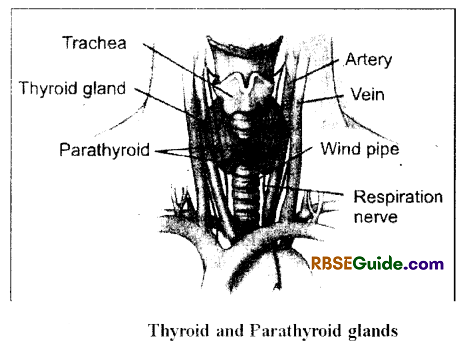
![]()
Thyroxine
General :
It is the main hormone of the thyroid gland. Kendall was first to prepare the crystals of the thyroxine. Harrington & Barger studied the molecular structure of the thyroxine.
It is secreted undertthe control of TSH. It is found in the lumen of the foll icles in the form of thyroglobulin.
Formation of Thyroxine
Thyroxine is made up of iodine & tyrosine. Formation of one molecule of thyroxine involves 2 molecules of tyrosine & 4 atoms of iodine. The tyrosin is 35% & the iodine is 65% of the thyroxine.
In the blood thyroxine is found in the form of 10% T3 & 90% T4.
T4 is the stable form of the thyroxine. The T4converts into T3 in the target cell to perform function. Hence. T3 is the functional form of thyroxine.
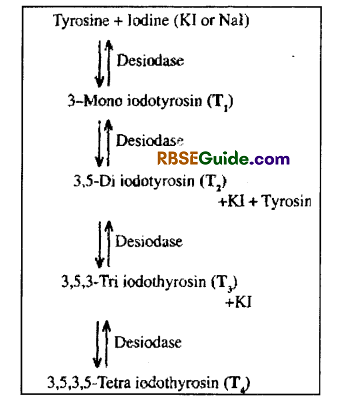
Functions of Thyroxine :
- It increases oxidative metabolism so rate of energy production increases or speed of life increases.
- It increases protein synthesis, gluconeogenesis. temperature of body and functions of nerves.
- It increases the glucose absorption, by intestine oxygen consumption and basic metabolic rate (BMR).
- It increases heart beat.
- It plays significant role in the metamorphosis of tadpole larva into frog.
- It plays role in osmotic regulation in cold-blooded vertebrates.
- It also increases activity of neurosecretion adrenalin and non-adrenalin.
Disorders Related to Thyroxine Hormone
(A) Hypothyroidism
Hypothyroidism deficiency of thyroid hormone may be due to malfunctioning of thyroid gland or deficiency of iodine in the diet.
It leads the following diseases-
(i) Cretinism- It occurs in children due to deficiency of thyroxine. It leads to dwarfism with serious mental deficiencies. Such individuals are called C retins.
Retarted body growth. Child looks as pot bellied, protruding tongue etc. Blood pressure, heart rate and Basal metabolic rate (BMR) are below normal. Such individuals may be sterile.
(ii) Myxedema :
- It occurs in adults due to deficiency of thyroxine.
- Puftmess of skin on the face and hands.
- The person becomes dull, lack intelligence and alertness, lack of memory.
- Blood pressure, heart rate and BMR are below normal.
- Skin becomes yellowish and decrease in reproductive ability. It can be cured by treating the patient with thyroxin tablets orally.
(iii) Goitre :
- This disease occurs due to lack of iodine in the food. Thyroid gland enlarges and neck of such patient becomes swollen.
- Less production of thyroxine due to unavailability of iodine, which is major constituent of thyroxine.
- This disease is more prevalent in people br ing at high attitude as thetr water lacks in iodine.
(iv) Hoshimoto’s Disease
It is caused due to formation of antibodies against the medicines given to cure diseases caused by hyposecretion of thyroid. These antibodies destroys thyroid gland. It is also called as Suicide of thyroid gland. It is an autoimmune disorder.
(B) Hyperthyroidism
Increases activity of thyroid gland produces excess of hormone in the body which increases rate of metabolic activities, rate of heart beat change in behaviour more sweat etc. It also cause oscillations in hands and feet. Hypersecretion of thyroxin results into following diseases.
(i) Exophthalmic Goiter – The over secretion of gland produces swelling in neck region, but in this disease goiter is accompanied by bulging of
eyeballs and vision of such person looks very fearing and eyes looks staring. This disease is called Grave’s disease.
(ii) Plumer’s disease : At various places formation of nodes / tumour in the thyroid gland is called plumer’s disease.
Calcitonin:
- It is secreted by the C-cells.
- It is also called as thyrocalcitonin.
- It causes hypocalcaemia in the blood i.e. less Ca++ in the blood.
- It is a iodine-free protein.
- It increases deposition of Ca++ in the bones & increases excretion of Ca++ in the kidney.
![]()
Parathyroid glands
Structure & Function
- There are 4 small & oval glands which are situated on the dorso-lateral sides of the thyroid.
- It was discovered by Raynord & its structure was given by Sandstrom.
- It’s length is 6mm, width is 3mm & weight is about 20 mg.
- It is the smallest endocrine gland.
- It secretes parathormone (PTH) which was discovered by collip. Hence, it is also called as Collip’s hormone.
- PTH is a simple protein which has 84 amino acids.
- This hormone controls calcium metabolism along with vit. D.
- The hormone increases blood Ca++ (Hypercalcium) & decreases PO43- . Accordingly, it increases absoiption
of Ca++, increases excretion of PO43- and dissolves out Ca++ from the bones. - Both the PTH & calcitonin function antagonastically.
Disorders of Parathormone
Hyposecretion of PTH reduces Ca++ & increases P04~3 in the blood. This causes increase in nerve and muscle functioning. The low level of parathormone leading to muscle spasms, sustained contractions or Hypocalcemic tetany in muscles of larynx, face, hands and feet.
Hypersecretion of PTH causes hypercalacaemia (increased Ca+A in the blood. This calcium is taken from the bones and hence bones becomes fragile, soft and porous, which is called Osteoporosis.
8 The increase level of calcium in plasma also leads to form calcification in tissues and in Kidneys, which is called Osteitis fibrosa cystica. For treatment of hypersecretion part of gland is removed.
Thymus Gland
- It is situated in the thoracic cavity near, the heart.
- It is meso – endodermal in origin and its structure is similar to the lymph gland.
- It is bounded by a Hassel’s capsule & it has ITassePs corpuscles or thymic cells.
- In human beings, the thymus gland increases in size with the age but with the onset of puberty, it degenerates
- It secretes thvmosine I. II & HI hormones which stimulates formation of immunity.
- It is the site for the maturation of training & maturation of T-lymphocytes.
- Excess secretion ofthymosine causes myasthenia gravis.
Functions of Thymosin hormone :
(i) It is responsible for immunity in the body.
(ii) Also helpful for maturation of reproductive glands.
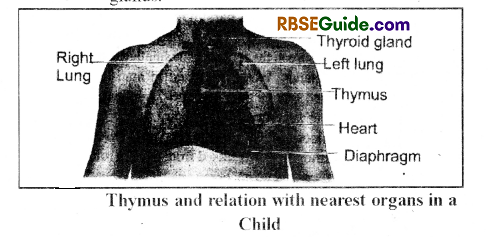
Pineal Body
- It is a (,) coma shaped gland which is situated at the base of of the cerebrum dorsally.
- It is also called as epiphysis cerebri & non-functional third eye.
- It has many lobes & connective tissues. The whole gland has granules of CaC03 or Ca3(PO)4 which are called as brain dust or acervuli.
- In human beings, the pineal gland begins degenerating at the age of 4 to 5 years. After 8 years, it gets calcified.
- It has pinealocytes & neuroglial cells.
- The pinealocytes have microvilli.
- The pineal body secretes one hormone in absence of light
(i) Melatonin
- It makes the skin lighter by acting as anti- MSH.
- It controls responsible for sleep-wake cycle.
- It functions as antigonal hormone.
- Pineal body is also called as “biological clock”.
Pancreas
Structure
It is a light pink coloured & irregular gland. Its length is 20 cm & it’s Weight is 60 gm.
It is a mixed gland which functions both as endocrine & exocrine gland.
Exocrine function is performed by acini which are about 15 lakh in number. They secrete pancreatic Juice.
The endocrine (i.e., hormone-producing) cells of the pancreas are grouped in the islets of Langerhans. Discovered in 1869 by the German pathological anatomist Paul Langerhans, the islets of Langerhans constitute approximately 1 to 2% ot the mass of the pancreas.
There are about one million islets in a healthy adult human pancreas, which are distributed evenly throughout the organ, and their combined weight is 1 to 1.5 grams.
Hormones produced in the Islets of Langerhans are secreted directly into the blood flow by (at least) five different types of cells:
- Beta cells producing Insulin and Amylin (65-80% of the total cells).
- Alpha cells releasing Glucagon (15-20%).
- Delta cells producing Somatostatin (3-10%).
- PP cells produces Pancreatic polypeptide- precursurs for alpha and Beta cells (3.5%).
- Epsilon cells produces Ghrelin. They are less than 1%.
- The above hormones are simple proteins & they are secreted under the control of GH. The insulin & glucagon control carbohydrate metabolism by the help of limit control feed back.
![]()
(i) Glucagon
- It is secreted by a-cells. It was discovered by Kimball & Murlin.
- This hormone stimulates glycogenolysis & gluconeogenesis.
- It increases blood glucose.
(ii) Insulin
- It is the first known hormone which is secreted by β – cells.
- Term ‘insulin’ was coined by Shaffer.
- Batting & Best prepared concentrate of the insulin & Ebel prepared the crystal of insulin.
- Sanger studied the molecular structure of the insulin. He stated that a molecule of insulin has two chains viz.
(i) α – chain-It has 21 amino acids
(ii) β – chain-It has 30 amino acids
- Both the chains remain linked by disulphide bonds. For this discover Sanger was given Nobel prize in 1958.
- It is the first hormone which is produced by genetic engineering.
- Insulin stimulates glycogenesis. It increases protein storage in the tissues. It increases
- lipolvsis in the blood & the liver. It decreases formation of Keton bodies.
- Deficiency of insulin causes diabetes mellitus.
Symptoms
(a) Hyperglycaemia Blood glucose is increased (Normal blood glucose is 80 to 120 mg%)
(b) Glycosauria-Excretion of glucose
(c) Diuresis or Polyurea-Formation of excess urine
(d) Polydypsia-Increased thirst
(e) Polyphagia Increased hunger
(f) Reduced body immunity
(g) Delayed healing of wounds
(h) Coma & eventually death.
Excess secretion of insulin causes hypoglycaemia. As a result of it, the brain cells feel tired & there is coma. It is called as insulin shock.
(iii) Somatostatin
- It is secreted by 5 – cells
- It is known to increase digestion, absorption & assimilation.
- It controls secretion of GH from the pituitary.
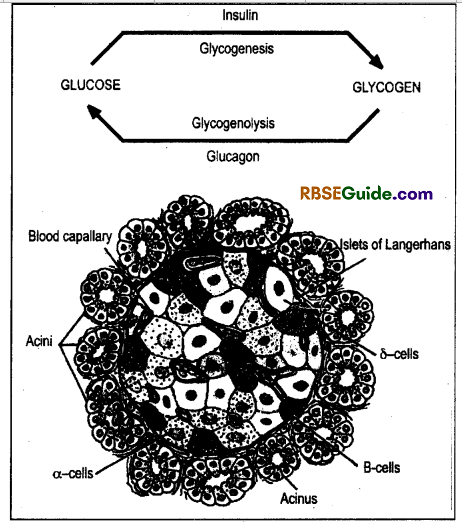
Adrenal Glands
There is a pair of adrenal glands which are situated on the kidneys as cap. Hence, they are also called as supra renal glands.
The weight of each gland is 5 gm.
This gland is also called as 4S because it is associated with salt, sugar, stress & sex.
The adrenal gland has 2 parts
(A) Cortex
(B) Medulla
Adrenal cortex
Structure
- It is the outer & light yellow coloured part which originates from the mesoderm.
- Its weight is about 4 gm & it forms 80 to 85% of the total gland.
- It secretes about many hormones which are collectively called as corticosteroids. They are under the control of
- ACTH. They are also called as life saving hormones.
The adrenal cortex has 3 parts
(a) Zona glomerulus:
- It is the outer part of the cortex which consists of small & cuboidal cells.
- It secretes mineralocorticoids eg. Aldosterone.
- These hormones are called as salt retaining hormones.
- These hormones maintain definite quantity of water, Na+, K+ & CF– in the ECF.
- These hormones stimulate absoiption.of Na+1 & Cl– & excertain of K+ in the kidneys.
(b) Zona fasciculata:
- It is the middle part of the cortex which consists of large & polyhedral cells.
- This part secretes glucocorticoids eg. cortisol, corticosterone etc.
- These hormones are used to treat allergy & help in organ transplantation.
- These hormones act as anti-inflammatory & help in the treatment of arthritis.
- These hormones stimulate glycogenesis & gluconeogenesis.
(c) Zona reticularis:
- It is the inner zone of the cortex which has cords of polyhedral cells. It also has modified glandular cells.
- This part secretes androgen, estrogen & progesterone in small quantity. These hormone affect sexual behaviour, hair growth, bones & muscles.
- The androgen is secreted in the form of dehydroxy-epi-andosteroe.
![]()
Diseases
(a) Addison’s disease: It is caused due to deficiency of mineralocorticoids
Symptoms : Reduced hunger, vometing, reduced BMR & body temperature, dehydration & bronzing of skin.
(b) Conn’s disease: It is caused due to excess secretion of mineralocorticoids.
Symptoms : Muscle weakness, high BP. malfunctioning of kidneys etc.
(c) Cushing’s disease: It is caused due to hyper secretion of corticosteroids. It is caused due to hyper secretion of corticosteroids which is due to excess of ACTH.
Symptoms : Virilism, oedema, hyperglyeaemia etc. In virilism opposite secondary sexual characters appear and it is more common in women. The virilism in female is also called as hirsutism.

Medulla
- It is the core part of the adrenal gland which is light brown in colour.
- It originates from neural ectoderm
- This part is not controlled by any pituitary- hormone.
- It’s chromaffin cells secrete two hormones viz.-
(a) Adrenalin or Epinephrin
(b) Nor-adrenalin or Nor-epinephrin
- These hormones are collectively called as Catecholamines (Amine acid derivatives)
- Their molecular structure was studied by Axelrod.
- These hormones are secreted in 4 : 1 ratio.
- They are also called as 3F hormones (Fear, Fight & Flight) and emergency hormons.
- They are also provide chemical defence mechanism by protecting the body from external & internal dangers.
- These hormones increase BP, heart beats, breathing rate. BMR, blood glucose, lipolysis, glycogenolvsis etc.
- They act as neurotransmittor.
